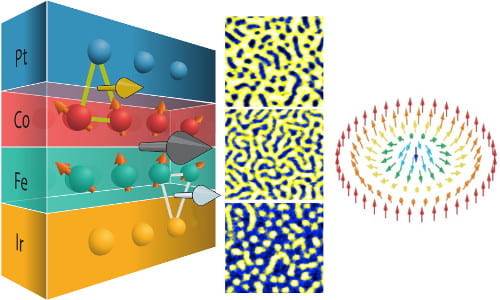The team of Prof. Christos Panagopoulos develops novel materials with “strong spin-orbit coupling”, meaning that the motion of the electrons inside the materials is strongly influenced by their intrinsic magnetic moment and angular momentum. These materials have unusual physical properties that are robust to impurities and temperature fluctuations, which makes them extremely promising for practical next-generation electronic and spintronic technologies.
Recently, the team developed an innovative technique for making materials containing tunable room-temperature “skyrmions” — tiny particle-like magnetic entities that only appear in specially-designed materials. Due to their stability, skyrmions have the potential to be used as magnetic bits in future magnetic storage and computing applications.

Left: schematic of the magnetic multilayer. Center: Measured magnetization of different samples, showing the appearance of skyrmions (yellow dots). Right: Schematic showing the configuration of magnetization vectors in a skyrmion. Figure credits: A. Soumyanarayanan et al.
By engineering a multi-layered Ir/Fe(x)/Co(y)/Pt nano-structure, the team was able to generate room temperature skyrmions with just the right size (less than 50 nm) to be suitable for technological applications. Furthermore, the team showed that the skyrmions could be detected and manipulated using processes commonly used in the electronics industry.
This work was published in the journal Nature Materials in 2017. Their next step is to demonstrate digital operations using these skyrmions, in nano-scale devices that can be integrated into microchips.
References:
- A. Soumyanarayanan, N. Reyren, A. Fert and C. Panagopoulos, Spin-orbit coupling induced emergent phenomena at surfaces and interfaces, Nature 539, 507 (2016).
- A. Soumyanarayanan, M. Raju, A. Oyarce, A. Tran, M. Im, A. Petrovic, P. Ho, K. Khoo, M. Tran, C. Gan, F. Ernult and C. Panagopoulos, Tunable room temperature magnetic skyrmions in Ir/Fe/Co/Pt multilayers, Nature Materials 16, 898 (2017).
